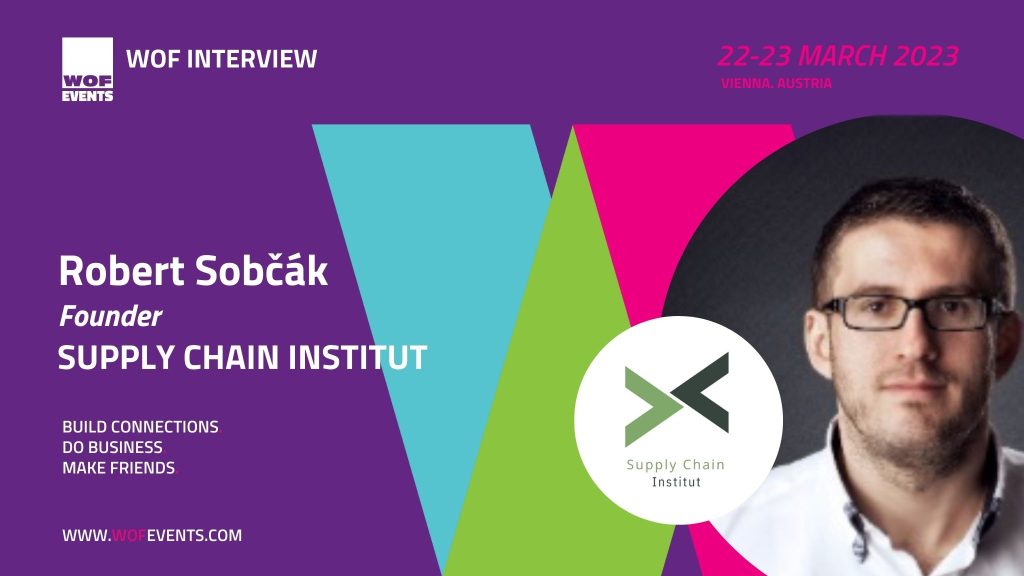Interview with Robert Sobčák, the founder of Supply Chain Institut
Robert Sobčák, the founder of Supply Chain Institut, is an expert in the field of supply chains with over 20 years of managerial and consulting experience in an international environment. It deals with topics focused on the efficiency, risks, and sustainability of supply chains (from purchasing to logistics). Currently, he actively evangelizes the topics of Truck2Train, sustainable city logistics as well as the issue of the shortage of truck drivers.
At WOF Summit Vienna, you will take part in the panel discussing “Sustainability in Road Freight – E-Trucks, Hydrogen, and Shift to Rail?”. Can you give us an insight into the actual situation in Europe?
Three-quarters of freight transport in Europe is still concentrated on roads. Freight by rail is only about 18 percent. Europe does not have a conceptual solution for freight transport. What worked in the past is now missing. We will be fixing for decades the lack of railway sidings in logistics zones. But you have to start somewhere.
Freight rail transport is considered an ecological solution and Europe has the ambition to solve it sustainability of freight transport by increasing its share, but this is not successful in the long term.
This is because the market of companies in freight transport cannot solve this problem by itself, and the state administration is not ready to comprehensively manage such systemic changes. Therefore, attention of many focuses on road transport and the replacement of internal combustion engines with batteries or hydrogen drive. In freight transport, however, electromobility is a much harder nut to crack than in passenger transport.
Why do states have a problem with project management of system changes when it is costly transportation?
The disadvantage of sustainable transport is its pan-European connection, the need for complex infrastructure and the involvement of players from different sectors of the economy. As for the European connection, railways have a place mainly in long-distance transport, which for smaller states always means international transfer. In Europe, there are relatively few suitable corridors that always work without obstacles.
What are the biggest shortcomings?
It is enough that some state in an important corridor starts long-term reconstruction, limited capacity gives priority to passenger rail transport and companies will switch to road transport. The complexity of infrastructure means that it is not enough to build a main corridor unless we can bring trains to it, when connecting lines do not have sufficient capacity, if we do not have sidings where we can load freight trains, we do not have terminals where we transfer containers from truck to train and vice versa.
What should be improved from the side of companies?
We need manufacturing and trading firms to use the railway, but we need to provide them with a functional railway with high-quality service and sufficient track capacity. We need carriers with quality service and the necessary capacity, who have customers who are interested in this service and we need quality infrastructure in sufficient capacity. All this needs to be coordinated and takes time for decades. Only rarely in Europe is such a change being systematically coordinated.
Are innovations needed in freight rail to move more goods from roads to railways?
Railway innovations are a specific topic. It is connected to the fact that the decision-making process implementation is very long in this sector. It has to do with an extraordinary focus on security. Some key innovations took decades before they were put into practice, but in reality, the goods on they will not bring the railway. One of the less visible but very important areas of innovation is noise reduction, especially when shifting in stations, which is the subject of criticism from people who live nearby stations. The freight railway needs to innovate in all aspects, not only technical but very much so in the field of digitization, in business, or in the education of experts. However, it is not yet an industry that would attract startups.
Today, we often talk about the Green Deal and sustainable solutions in many areas. Where are the plans of states and cities failing to classify railways as more ecological solutions systematically?
The railway is often included in plans in many states. The problem is that those plans in a long-term fail to implement. One more aspect can be mentioned – unfortunately, freight transport has to compete for capacity with passengers, where it is generally true that passenger transport has priority over rail freight and the capacity that freight traffic receives is reduced. While everyone probably understands that, from an environmental benefit point of view, it is better to get a freight train on the tracks to replace for example 35 trucks rather than a half-empty train with twelve passengers.
What do you suggest to improve the Truck2Train activity?
Such complex changes cannot be solved by the market alone. A coordinating role of the state administration is necessary. It’s not enough to focus only on selected investment projects of the TEN-T type, there is a need to build a new one overall architecture of freight transport in Europe. There is a need to systematically think about how we transport containers that arrive on ships at ports and travel across the continent and how we move goods from factories to large warehouses on the outskirts of cities and so on.
Also, it is necessary to address what obstacles rail transport has to overcome at the borders, how we coordinate the closures of important transport arteries, what capacity on the track we allocate to freight by train, how we enable the use of free train capacities, how far we are in digitization documents, business, dispatching or operations, how insurance works and many others factors. Many activities are taking place throughout Europe, but as a whole, they do not bring long-term effects, which we need to increase the sustainability of freight transport. That is why we need to plan, coordinate and manage this process as a whole.
We need more and more modern multimodal terminals across Europe where we could transfer containers onto a truck. We need the same and also more freight railway stations where goods are loaded and unloaded onto the train. But they probably struggle with that all cities, residents defend themselves against such terminals and in general we rather get rid of them.
Are there examples from abroad where improvements have been made in this direction?
All of Europe is struggling with this problem. From my point of view, the furthest in looking at obstacles that prevent more companies from using railway transport, are Germans. They created a non-profit organization Allianz pro Schiene, funded primarily by the Ministry of Transport, which manages to connect companies from the railway and road sectors and slowly remove barriers on the market.

